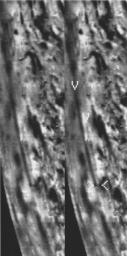
|
Triton’s Dark Plume
- Click the image above for a larger view
- Full-Res JPEG (932 x 1884) (206.8 kB)
- Full-Res TIFF (932 x 1884) (1.8 MB)
Caption:
A several-kilometers-tall, geyser-like eruption of dark material is seen shooting almost straight up from the surface of Neptune's moon, Triton, in this Voyager 2 image, acquired on Aug. 24, 1989, from a distance of 99,920 kilometers (about 62,000 miles). This dark plume first discovered in stereo images taken by Voyager 2 consists of a narrow stem that rises vertically nearly eight kilometers (five miles), forming a cloud that drifts 150 kilometers (90 miles) westward in Triton's winds. The image shows the geyser-like column nearly in profile, as the spacecraft was only 16 degrees above the hotizon as seen from Triton's surface at the base of the plume. While Voyager scientists are still trying to determine the mechanism responsible for the eruption, one possibility being considered is that pressurized gas, probably nitrogen, rises from beneath the surface and carries aloft dark particles, probably including carbon-rich materials and possibly ice crystals. The plume carries the particles to an altitude where they are left suspended as a westward-drifting cloud. (The same image is shown in the upper and lower panels; the lower panel is marked to indicate the top and bottom of the plume, the lateral extent of the cloud, and the visible extent of the cloud's shows.)
Background Info:
The Voyager Project is managed for NASA's Office of Space Science and Applications by the Jet Propulsion Laboratory.
Cataloging Keywords:
| Name | Value | Additional Values |
|---|---|---|
| Target | Triton | |
| System | Neptune | |
| Target Type | Satellite | |
| Mission | Voyager | |
| Instrument Host | Voyager 2 | |
| Host Type | Flyby Spacecraft | |
| Instrument | ||
| Detector | ||
| Extra Keywords | Grayscale, Plume | |
| Acquisition Date | ||
| Release Date | 1989-10-02 | |
| Date in Caption | 1989-08-24 | |
| Image Credit | NASA/JPL | |
| Source | photojournal.jpl.nasa.gov/catalog/PIA14448 | |
| Identifier | PIA14448 | |
